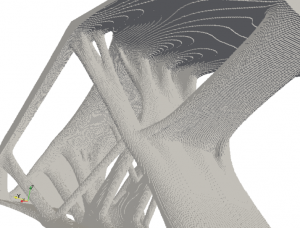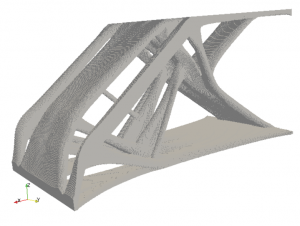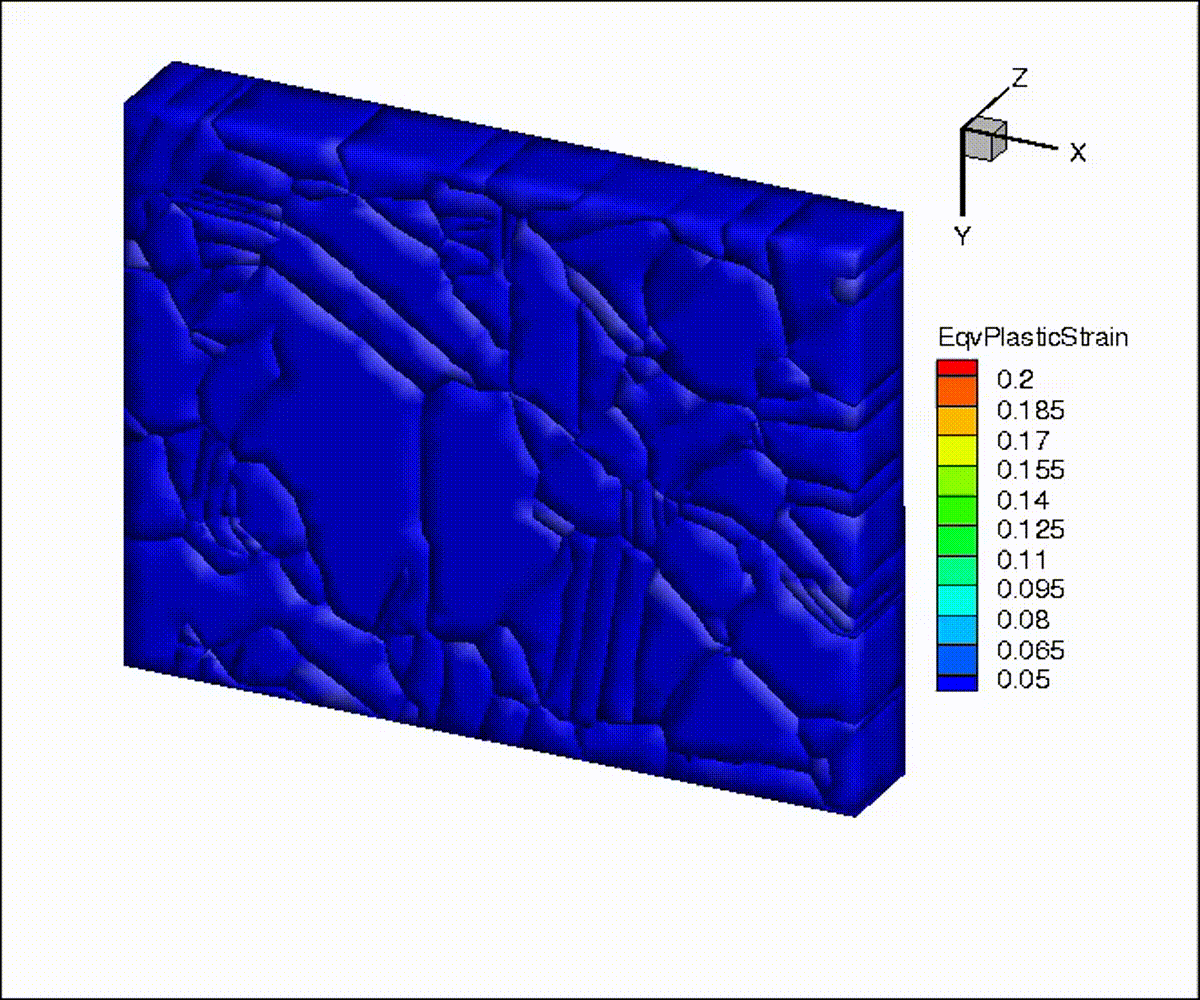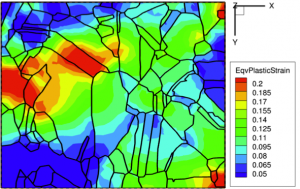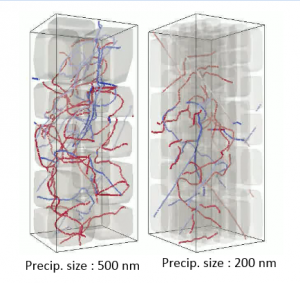Applications
Statistical Characterization and Reconstruction of a sub-grain γγ’ Microstructure of Ni based superallo Rene’ 88DT
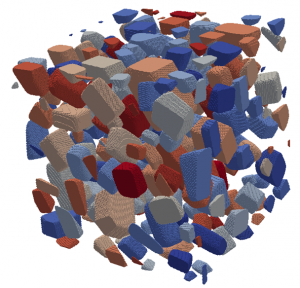 This project focuses on the statistical characterization and subsequent reconstruction of a sub-grain γγ’ microstructure from the Ni based superalloy Rene’ 88DT. The effect of Microstructural parameters on the material response can be obtained by perturbing the input parameters of the reconstruction method and performing a crystal plasticity FEM simulation.
This project focuses on the statistical characterization and subsequent reconstruction of a sub-grain γγ’ microstructure from the Ni based superalloy Rene’ 88DT. The effect of Microstructural parameters on the material response can be obtained by perturbing the input parameters of the reconstruction method and performing a crystal plasticity FEM simulation.
Image Courtesy of Maxwell Pinz, from Prof. Somnath Ghosh’s Computational Mechanics Research Laboratory (CMRL)
Funded by AFOSR/AFRL- FA9550-12-1-0445 through CEIMM
Modeling of Hardening and Dislocation Twin Boundary Interactions in Magnesium
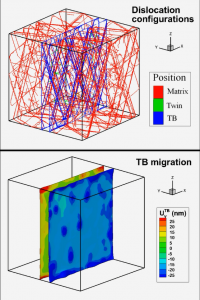 This project focuses on quantifying the effect of dislocation-twin boundary interactions, initial dislocation density, twin thickness, and twin volume fraction on the hardening response of magnesium using large scale three-dimensional discrete dislocation dynamics simulations.
This project focuses on quantifying the effect of dislocation-twin boundary interactions, initial dislocation density, twin thickness, and twin volume fraction on the hardening response of magnesium using large scale three-dimensional discrete dislocation dynamics simulations.
A video of dislocation interactions with a twin boundary and the twin boundary migration can be accessed from the following link: https://www.youtube.com/watch?v=k218LFGPFfU
Image Courtesy of Prof. Jaafar El-Awady from the Computational and Experimental Materials Engineering Laboratory
Funded by NSF and ARL
Multi-Scale Computational Models for Fatigue Predictions in Polycrystalline Aluminum Alloys
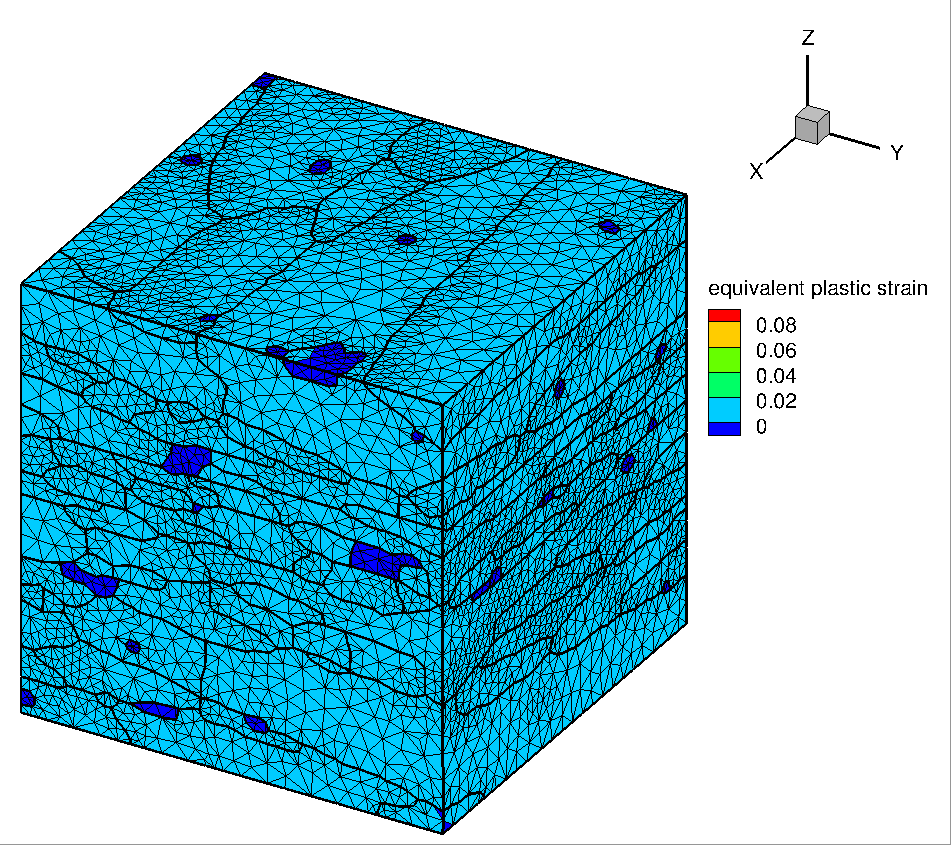 This project focuses on the image-based crystal plasticity finite element modeling of polycrystalline microstructures of the two-phase aluminum 7000 series alloys to predict finite deformation variables and localization.
This project focuses on the image-based crystal plasticity finite element modeling of polycrystalline microstructures of the two-phase aluminum 7000 series alloys to predict finite deformation variables and localization.
Image Courtesy of Xiaohui Tu, from Prof. Somnath Ghosh’s Computational Mechanics Research Laboratory (CMRL)
Funded by NAVAIR
Topology Optimization under Additive Manufacturing Constraints
This project focuses on developing topology optimization-based design methods that are fully integrated and compatible with the additive manufacturing process of 3D sand printing (3DSP), a process where metal parts are made by casting molten metal into 3D printed sand molds. Both the casting and 3D printing processes impose constraints on component geometry and these constraints are mathematically incorporated into the topology optimization methodology.
The topology optimization approach has its roots in projection-based algorithms where manufacturing design variables are coupled to the physical and analysis spaces to naturally achieve manufacturability. Preliminary efforts are focusing on components designed for mechanical properties of stiffness and strength.
Image Courtesy of Prof. James K. Guest of the Topology Optimization Group
Funded by NSF
Modeling of Deformation and Fracture in Multi-Scale Ti-64 Alloy
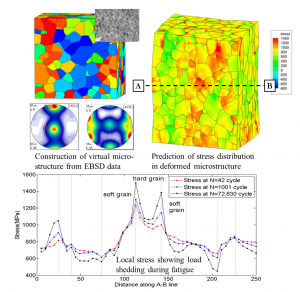 Crystal plasticity based studies are conducted in collaboration with Pratt & Whitney on cyclic and dwell fatigue simulations of Ti-6Al-4V aerospace application alloys. The virtual microstructure for simulations are reconstructed from sectioning EBSD experimental images, followed by microstructure conforming mesh generation. Then crystal plasticity models with wavelet-based multi-time scale integration method (WATMUS) are used to simulate cyclic/dwell fatigue up to crack initiation at cycles. The high fidelity local stress and dislocation distributions are used in a dislocation pile-up and load shedding mechanism based model to predict crack nucleation. The propagation of crack based on phase field modeling is under development.
Crystal plasticity based studies are conducted in collaboration with Pratt & Whitney on cyclic and dwell fatigue simulations of Ti-6Al-4V aerospace application alloys. The virtual microstructure for simulations are reconstructed from sectioning EBSD experimental images, followed by microstructure conforming mesh generation. Then crystal plasticity models with wavelet-based multi-time scale integration method (WATMUS) are used to simulate cyclic/dwell fatigue up to crack initiation at cycles. The high fidelity local stress and dislocation distributions are used in a dislocation pile-up and load shedding mechanism based model to predict crack nucleation. The propagation of crack based on phase field modeling is under development.
Image Courtesy of Jiahao Cheng, from Prof. Somnath Ghosh’s Computational Mechanics Research Laboratory (CMRL)
Funded by AFRL-managed Metals Affordability Initiative
Crystal Plasticity Modeling of Ni-based Superalloy Rene’ 88DT
This project focuses on developing a model to capture crack nucleation sites in Ni-based superalloy Rene’ 88DT under fatigue loading. Both experimental and simulation results show significant plastic strain accumulation near critical twin boundaries (microcrack location). Such analyses are important for application of Ni-based superalloys in aerospace structures.
Image Courtesy of Akbar Bagri and George Weber, from Prof. Somnath Ghosh’s Computational Mechanics Research Laboratory (CMRL)
Funded by AFOSR/AFRL- FA9550-12-1-0445 through CEIMM
Parametrically Homogenization Based Continuum Damage Mechanics Model for Composites
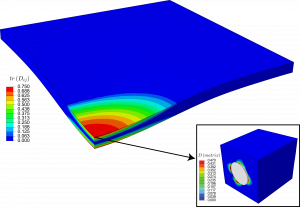 This project develops a computationally efficient multi-scale damage model for composite materials. A direct connection is built between the microscopic failure mechanisms and macroscopic constitutive behavior through parametric homogenization. Therefore, with affordable computational cost, this model renders detailed failure behaviors of composite structure in both micro- and macro-scales, providing us significant insight for the design of composite structures.
This project develops a computationally efficient multi-scale damage model for composite materials. A direct connection is built between the microscopic failure mechanisms and macroscopic constitutive behavior through parametric homogenization. Therefore, with affordable computational cost, this model renders detailed failure behaviors of composite structure in both micro- and macro-scales, providing us significant insight for the design of composite structures.
Image Courtesy of Xiaofan Zhang, from Prof. Somnath Ghosh’s Computational Mechanics Research Laboratory (CMRL)
Funded by CMEDE of Army Research Laboratory
Predicting Damage and Surface Roughness Evolution in Face Centered Cubic Microcrystals
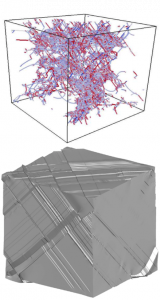 This project focuses on predicting the effect of crystal size on the evolution of dislocation patterns and surface roughness in free standing Ni single crystals.
This project focuses on predicting the effect of crystal size on the evolution of dislocation patterns and surface roughness in free standing Ni single crystals.
A video showing the predicted surface roughness evolution as predicted from discrete dislocation dynamics simulations can be accessed from the following link: https://www.youtube.com/watch?v=O1Jf2FzV7kQ
Image Courtesy of Prof. Jaafar El-Awady from the Computational and Experimental Materials Engineering Laboratory
Funded by DARPA
Multi-Scale Modeling of Deformation and Fatigue in Polycrystalline Titanium Alloys
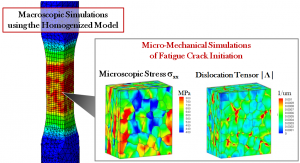 In this project, we develop microstructure-sensitive multi-scale models through parametric homogenization of crystal plasticity finite element (CPFE) models. The multi-scale model is then used to predict fatigue crack initiation in macroscopic test specimens of Titanium alloys, by imposing the deformation histories of critical material points in the fatigue specimen as boundary conditions to micromechanical models.
In this project, we develop microstructure-sensitive multi-scale models through parametric homogenization of crystal plasticity finite element (CPFE) models. The multi-scale model is then used to predict fatigue crack initiation in macroscopic test specimens of Titanium alloys, by imposing the deformation histories of critical material points in the fatigue specimen as boundary conditions to micromechanical models.
Image Courtesy of Deniz Ozturk, from Prof. Somnath Ghosh’s Computational Mechanics Research Laboratory (CMRL)
Funded by AFRL – Collaborative Center of Structural Sciences
Computational Models for Fatigue Failure Predictions in Polycrystalline Aluminum Alloys

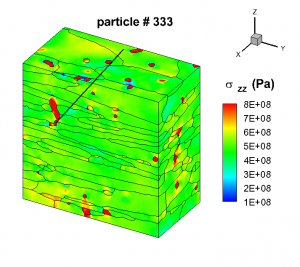 This project focuses on modeling fatigue failure in polycrystalline bi-phasic Al alloys by coupling an image-based crystal plasticity finite element model with a thermodynamically-consistent crack phase field model. Wavelet transformation induced multi-time scaling (WATMUS) model is also used to accelerate simulation of microstructures under cyclic loading.
This project focuses on modeling fatigue failure in polycrystalline bi-phasic Al alloys by coupling an image-based crystal plasticity finite element model with a thermodynamically-consistent crack phase field model. Wavelet transformation induced multi-time scaling (WATMUS) model is also used to accelerate simulation of microstructures under cyclic loading.
Image Courtesy of Xiaohui Tu and Ahmad Shahba, from Prof. Somnath Ghosh’s Computational Mechanics Research Laboratory (CMRL)
Funded by NAVAIR
Probabilistic Parametric Homogenization for Structure-Materials Modeling
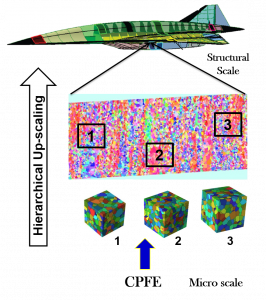 This project focuses on developing probability based structural-scale elasto-plastic and fatigue damage models from detailed micro-mechanical simulations. Initial developments include obtaining deterministic models for polycrystals in terms of microstructural morphological parameters. The uncertainty in these parameters is accounted for in the structural-scale models using probability based models.
This project focuses on developing probability based structural-scale elasto-plastic and fatigue damage models from detailed micro-mechanical simulations. Initial developments include obtaining deterministic models for polycrystals in terms of microstructural morphological parameters. The uncertainty in these parameters is accounted for in the structural-scale models using probability based models.
Image Courtesy of Shravan Kotha, from Prof. Somnath Ghosh’s Computational Mechanics Research Laboratory (CMRL)
Funded by AFRL Structural Science Center
Modeling Dislocation Mediated Plasticity in Ni-Based Superalloy Microcrystals
This work investigates the effect of precipitate volume fraction, channel width and APB energy on the deformation in Ni-based superalloy microcrystals using large scale 3D dislocation dynamics simulations.
A video of the evolution of dislocation microstructure during the deformation of Ni-based superalloys can be accessed from the following link: https://www.youtube.com/watch?v=SII-A-mXszw
Image Courtesy of Prof. Jaafar El-Awady from the Computational and Experimental Materials Engineering Laboratory
Funded by AFRL
Concurrent atomistic-continuum model for developing self-consistent constitutive relations of crystalline materials with cracks.
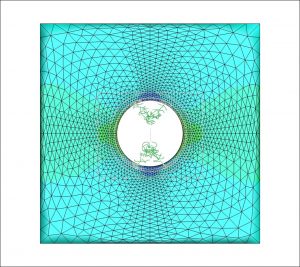 This work focuses on developing the continuum level constitutive relation of crystalline materials with defects. Most critical part of the domain is resolved up to atomic level(MD) and rest is continuum(CPFE). Concurrent atomistic-continuum model is used for the coupled simulation. Also Hyperdynamics is incorporated within Molecular Dynamics to bridge the time scale difference between atomistic and continuum domain.
This work focuses on developing the continuum level constitutive relation of crystalline materials with defects. Most critical part of the domain is resolved up to atomic level(MD) and rest is continuum(CPFE). Concurrent atomistic-continuum model is used for the coupled simulation. Also Hyperdynamics is incorporated within Molecular Dynamics to bridge the time scale difference between atomistic and continuum domain.
Image Courtesy of Subhendu Chakraborty, from Prof. Somnath Ghosh’s Computational Mechanics Research Laboratory (CMRL)
Funded by NSF
Multi‐time scale finite element simulations of coupled multi-physics phenomena in electro-magnetic-mechanical fields with a continuum damage model for
This project develops an accurate and efficient finite element model for simulating coupled transient electromagnetic and dynamic mechanical fields that differ widely in the frequency ranges. This coupled modeling framework is necessary for effective modeling and simulation of structures such as antennae that are governed by multi-physics problems operating in different frequency and temporal regimes.
One major challenge in computational modeling of many piezoelectric devices including actuator and sensor structures is the large discrepancies in the frequencies of electrical signal and mechanical vibrations and this requires simulating a large number of cycles with electric excitation time period for reaching to a state of mechanical deformation in the time domain. The present work addresses these issues by developing the wavelet transformation based multi-time scaling (WATMUS) finite element model for dynamic piezoelectric simulations in finite deformation.
Image Courtesy of Reza Yaghmaie, from Prof. Somnath Ghosh’s Computational Mechanics Research Laboratory (CMRL)
Funded by AFOSR



